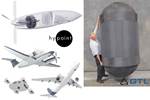Hexagon Composites acquires 40% stake in cryogenic tank technology company
Potentially disruptive liquid (renewable) natural gas and liquid hydrogen technologies to be further developed and scaled up between Hexagon Composites and Hexagon Purus.

Cryoshelter cryogenic tank technology. Photo Credit: Hexagon Group
On April 21, Hexagon Composites (Ålesund, Norway) signed an agreement to acquire a 40% stake in Cryoshelter GmbH, a Dobl, Austria-based company specialized in the development of cryogenic tank technology for liquid (renewable) natural gas (LNG) and liquid hydrogen (LH2).
The Hexagon Group provides compressed natural gas (CNG), including renewable natural gas (RNG), compressed hydrogen and battery-electric systems as part of its portfolio of clean fuel solutions. Storage of LNG and LH2 will add a new dimension to its existing offering, complementing its portfolio and unlocking new opportunities for Hexagon Agility (Costa Mesa, Calif., U.S.) and Hexagon Purus (Ålesund), respectively.
“Cryoshelter has a potentially disruptive technology with competitive edge compared to existing technology alternatives in the market. Our goal is to aid the commercialization and industrialization of this technology,” Jon Erik Engeset, CEO of Hexagon Composites, says. “The addition of Cryoshelter’s technology extends our product portfolio to include leading liquid gas solutions. This will further strengthen our efforts to drive decarbonization in the heavy-duty transport sector, support Europe and other key geographies in securing energy independence and reinforce our position as a global leader in clean energy solutions.”
Hexagon Composites ASA will make an initial investment of €2.5 million to acquire 40% of Cryoshelter’s LNG business, with options to buy remaining interests over the next three to 10 years. Together, with Cryoshelter, Hexagon says it will further develop the technology and scale up the business over the coming years.
Hexagon Purus ASA (owned 73.3% by Hexagon Composites) will make an initial investment of €3.5 million to acquire 40% of Cryoshelter’s LH2 business, with options to buy remaining interests over the next five to 10 years. Together, with Cryoshelter, Hexagon Purus reports it will further develop the technology and business over the coming years.
The separation of Cryoshelter’s LNG and LH2 businesses recognizes the different phases of market and product development. There is an established market for LNG mobility solutions, Hexagon Composites notes, and Cryoshelter’s technology is already at a pre-commercial stage, while the market and products for LH2 storage are in the early stage of development with longer timeframe to commercialization.
Supported by European legislation, it is expected that renewable natural gas, alongside battery-electric and fuel cell-electric technologies will play a key role in the efforts to decarbonize the commercial transportation sector in Europe.
Closing of the transaction is expected to take place by the Q3 2022, subject to fulfillment of certain closing conditions and customary regulatory approvals.
Related Content
-
Update: THOR project for industrialized, recyclable thermoplastic composite tanks for hydrogen storage
A look into the tape/liner materials, LATW/recycling processes, design software and new equipment toward commercialization of Type 4.5 tanks.
-
Hexagon Purus Westminster: Experience, growth, new developments in hydrogen storage
Hexagon Purus scales production of Type 4 composite tanks, discusses growth, recyclability, sensors and carbon fiber supply and sustainability.
-
On the radar: Cryogenic testing of composites for future hydrogen storage
Netherlands, U.K., France, Germany and the U.S. build up test capability, look at thermoset and thermoplastic composite materials.















